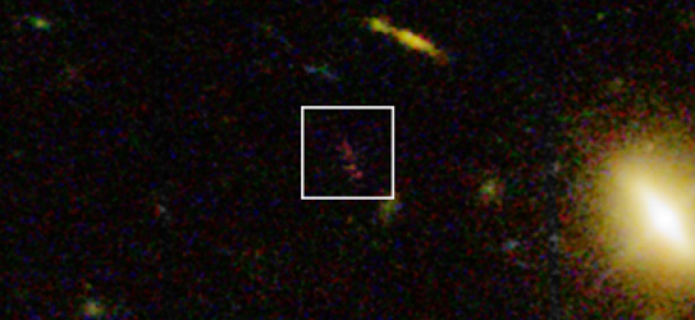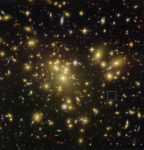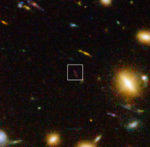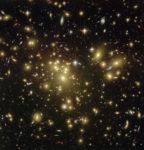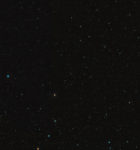ALMA and VLT probe an Old-looking Galaxy in a Young Universe
2 March, 2015 / Read time: 9 minutes
One of the most distant galaxies ever observed has provided astronomers with the first detection of dust in such a remote star-forming system and tantalizing evidence for the rapid evolution of galaxies after the Big Bang. The new observations have used the Atacama Large Millimeter/submillimeter Array (ALMA) to pick up the faint glow from cold dust in the galaxy A1689-zD1 and used ESO's Very Large Telescope (VLT) to measure its distance.
A team of astronomers, led by Darach Watson from the University of Copenhagen, used ALMA and theVLT's X-shooter instrument to observe one of the youngest and most remote galaxies ever found. They were surprised to discover a far more evolved system than expected. It had a fraction of dust similar to a very mature galaxy, such as the Milky Way. Such dust is vital to life, because it helps form planets, complex molecules and normal stars.
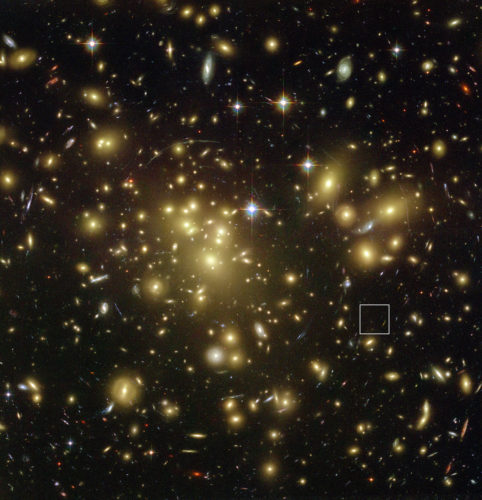
Ubicación de la lejana y polvorienta galaxia A1689-zD1 detrás el cúmulo de galaxias Abell 1689 (con anotaciones) Esta espectacular vista desde el telescopio espacial Hubble de NASA/ESA muestra al rico cúmulo de galaxias Abell 1689. La enorme concentración de masa dobla la luz procedente de objetos más distantes y puede aumentar su brillo total aparente, haciéndolos visibles. Señalado con un recuadro, vemos uno de estos objetos: A1689-zD1 (aunque apenas es visible en esta foto). Nuevas observaciones llevadas a cabo con ALMA y el telescopio VLT de ESO han revelado que este objeto es una galaxia polvorienta vista cuando el Universo tenía tan sólo 700 millones de años. Crédito: NASA; ESA; L. Bradley (Universidad Johns Hopkins); R. Bouwens (Universidad de California, Santa Cruz); H. Ford (Universidad Johns Hopkins); y G. Illingworth (Universidad de California, Santa Cruz).
The target of their observations is called A1689-zD1 [1]. It is observable only by virtue of its brightness being amplified more than nine times by a gravitational lens in the form of the spectacular galaxy cluster, Abell 1689, which lies between the young galaxy and the Earth. Without the gravitational boost, the glow from this very faint galaxy would have been too weak to detect.
We are seeing A1689-zD1 when the Universe was only about 700 million years old — five percent of its present age [2]. It is a relatively modest system — much less massive and luminous than many other objects that have been studied before at this stage in the early Universe and hence a more typical example of a galaxy at that time.
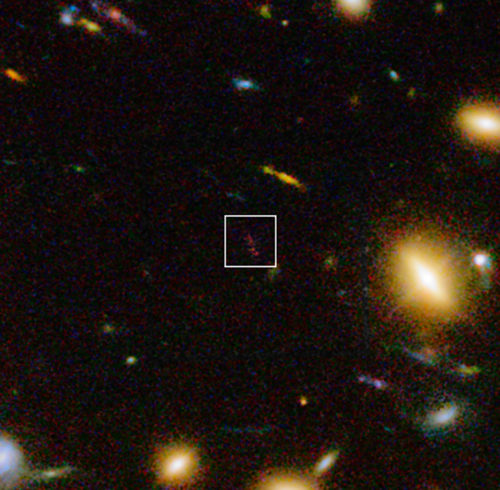
Vista infrarroja de la lejana y polvorienta galaxia A1689-zD1 detrás del cúmulo de galaxias Abell 1689 Esta vista en luz infrarroja del instrumento WFC3, instalado en el telescopio espacial Hubble de NASA/ESA, muestra parte del rico cúmulo de galaxias Abell 1689. La enorme concentración de masa dobla la luz procedente de objetos más distantes y puede aumentar su brillo total aparente, haciéndolos visibles. Uno de estos objetos, A1689-zD1, se señala en esta imagen. Nuevas observaciones llevadas a cabo con ALMA y el telescopio VLT de ESO, han revelado que este objeto es una galaxia polvorienta vista cuando el Universo tenía tan sólo 700 millones de años. Su luz ha sido aumentada en un factor de más de nueve debido al efecto de lente gravitacional generado por el cúmulo masivo. Crédito: ESO/J. Richard
A1689-zD1 is being observed as it was during the period of reionization, when the earliest stars brought with them a cosmic dawn, illuminating for the first time an immense and transparent Universe and ending the extended stagnation of the Dark Ages. Expected to look like a newly formed system, the galaxy surprised the observers with its rich chemical complexity and abundance of interstellar dust.
"After confirming the galaxy's distance using the VLT," said Darach Watson, "we realized it had previously been observed with ALMA. We didn't expect to find much, but I can tell you we were all quite excited when we realized that not only had ALMA observed it, but that there was a clear detection. One of the main goals of the ALMA Observatory was to find galaxies in the early Universe from their cold gas and dust emissions — and here we had it!".
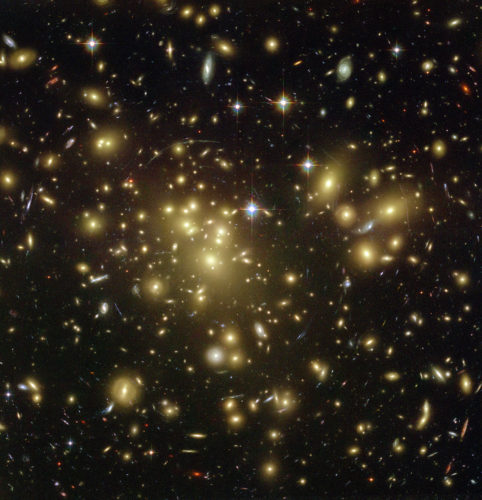
La lejana y polvorienta galaxia A1689-zD1 en el cúmulo de galaxias Abell 1689 Esta espectacular vista desde el telescopio espacial Hubble de NASA/ESA muestra al rico cúmulo de galaxias Abell 1689. La enorme concentración de masa dobla la luz procedente de objetos más distantes y puede aumentar su brillo total aparente, haciéndolos visibles. Señalado con un recuadro, vemos uno de estos objetos: A1689-zD1 (aunque apenas es visible en esta foto). Nuevas observaciones llevadas a cabo con ALMA y el telescopio VLT de ESO, han revelado que este objeto es una galaxia polvorienta vista cuando el Universo tenía tan sólo 700 millones de años. Crédito: NASA; ESA; L. Bradley (Universidad Johns Hopkins); R. Bouwens (Universidad de California, Santa Cruz); H. Ford (Universidad Johns Hopkins); and G. Illingworth (Universidad de California, Santa Cruz).
This galaxy was a cosmic infant — but it proved to be precocious. At this age it would be expected to display a lack of heavier chemical elements — anything heavier than hydrogen and helium, defined in astronomy as metals. These are produced in the bellies of stars and scattered far and wide once the stars explode or otherwise perish. This process needs to be repeated for many stellar generations to produce a significant abundance of the heavier elements such as carbon, oxygen and nitrogen.
Surprisingly, the galaxy A1689-zD1 seemed to be emitting a lot of radiation in the far infrared [3], indicating that it had already produced many of its stars and significant quantities of metals, and revealed that it not only contained dust, but had a dust-to-gas ratio that was similar to that of much more mature galaxies.
"Although the exact origin of galactic dust remains obscure," explains Darach Watson, "our findings indicate that its production occurs very rapidly, within only 500 million years of the beginning of star formation in the Universe — a very short cosmological time frame, given that most stars live for billions of years."".
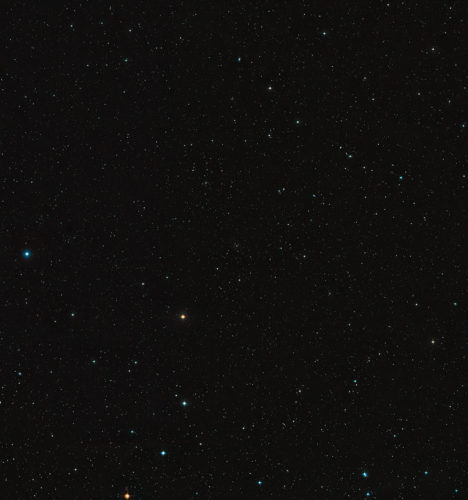
Visión de amplio campo del cielo que rodea al rico cúmulo de galaxias Abell 1689 Esta imagen, fruto del sondeo Digitized Sky Survey 2, muestra la región del cielo que rodea al rico cúmulo de galaxias Abell 1689 en la constelación de Virgo. También pueden verse muchas otras galaxias, mucho más cercanas. Crédito: ESO/Digitized Sky Survey 2
The findings suggest A1689-zD1 to have been consistently forming stars at a moderate rate since 560 million years after the Big Bang, or else to have passed through its period of extreme starburst very rapidly before entering a declining state of star formation.
Prior to this result, there had been concerns among astronomers that such distant galaxies would not be detectable in this way, but A1689-zD1 was detected using only brief observations with ALMA.
Kirsten Knudsen (Chalmers University of Technology, Sweden), co-author of the paper, added, "This amazingly dusty galaxy seems to have been in a rush to make its first generations of stars. In the future, ALMA will be able to help us to find more galaxies like this, and learn just what makes them so keen to grow up."
Notes
[1] This galaxy was noticed earlier in the Hubble images, and suspected to be very distant, but the distance could not be confirmed at that time.
[2] This corresponds to a redshift of 7.5.
[3] This radiation is stretched by the expansion of the Universe into the millimeter wavelength range by the time it gets to Earth and hence can be detected with ALMA.
More information
This research was presented in a paper entitled "A dusty, normal galaxy in the epoch of reionization" by D. Watson et al., to appear online in the journal Nature on 2 March 2015.
The team is composed of D. Watson (Niels Bohr Institute, University of Copenhagen, Denmark), L. Christensen (University of Copenhagen), K.K. Knudsen (Chalmers University of Technology, Sweden), J. Richard (CRAL, Observatoire de Lyon, Saint Genis Laval, France), A. Gallazzi (INAF-Osservatorio Astrofisico di Arcetri, Firenze, Italy) and M. J. Michalowski (SUPA, Institute for Astronomy, University of Edinburgh, Royal Observatory, Edinburgh, UK).
The Atacama Large Millimeter/submillimeter Array (ALMA), an international astronomy facility, is a partnership of the European Organisation for Astronomical Research in the Southern Hemisphere (ESO), the U.S. National Science Foundation (NSF) and the National Institutes of Natural Sciences (NINS) of Japan in cooperation with the Republic of Chile. ALMA is funded by ESO on behalf of its Member States, by NSF in cooperation with the National Research Council of Canada (NRC) and the Ministry of Science and Technology (MOST) in Taiwan and by NINS in cooperation with the Academia Sinica (AS) in Taiwan and the Korea Astronomy and Space Science Institute (KASI).
ALMA construction and operations are led by ESO on behalf of its Member States; by the National Radio Astronomy Observatory (NRAO), managed by Associated Universities, Inc. (AUI), on behalf of North America; and by the National Astronomical Observatory of Japan (NAOJ) on behalf of East Asia. The Joint ALMA Observatory (JAO) provides the unified leadership and management of the construction, commissioning and operation of ALMA.
Contact:
Valeria Foncea
Education and Public Outreach Officer
Joint ALMA Observatory
Santiago, Chile
Tel: +56 2 467 6258
Cell: +56 9 75871963
Email: [email protected]
Darach Watson
Niels Bohr Institute
University of Copenhagen, Denmark
Tel: +45 2480 3825
E-mail: [email protected]
Kirsten K. Knudsen
Chalmers University of Technology
Onsala, Sweden
Tel.: +46 31 772 5526
Cel: +46 709 750 956
E-mail: [email protected]
Masaaki Hiramatsu
Education and Public Outreach Officer, NAOJ Chile
Observatory Tokyo, Japan
Tel: +81 422 34 3630
E-mail: [email protected]
Charles E. Blue
Public Information Officer
National Radio Astronomy Observatory
Charlottesville, Virginia, USA
Tel: +1 434 296 0314
Cell: +1 434.242.9559
E-mail: [email protected]
Richard Hook
Public Information Officer, ESO
Garching bei München, Germany
Tel: +49 89 3200 6655
Cell: +49 151 1537 3591
Email: [email protected]
